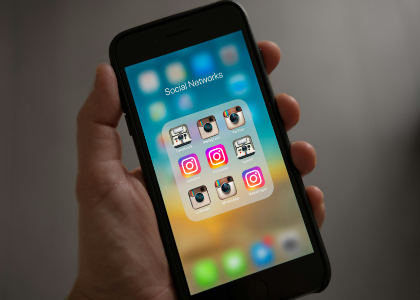Blog

8 Innovations Shaping the Future of Branding and Marketing
The future of branding and marketing has become an exciting discussion from year to year. Over the past while, Artificial Intelligence (AI) has taken center stage to help businesses make more efficient marketing efforts, from producing content to targeting audiences.
In 2024, we can expect beyond AI. There are more innovations and trends in marketing that can truly shape the way you connect with the target audience. For example, the return of offline marketing is one of the recent rising trends.
So, we've compiled eight innovations expected to shape branding and marketing this year. From creating short videos to performing intentionality in your marketing, these emerging trends can help you dominate the industry!
Short Narrated Videos
Video marketing is still winning, especially short narrated videos. Whether it's recorded footage or animated explainers, narrated videos have shown the power to engage viewers longer. They align with the demand for easily digestible yet compelling material.
These short narrated videos are particularly well-suited for the fast-paced environment of social media. You can communicate your brand's stories, showcase products, or deliver key messages concisely and compellingly.
Consider incorporating diverse styles of video. For example, animated videos are effective in driving positive impacts on brands, as 40.8% of marketers stated. Animated videos with voiceovers can also help you raise brand awareness.
Employees as the New Influencers
While influencer marketing has raised as a trend, companies have been flipping the script. More and more brands trust their employees to create content by turning them into real influencers for social media content.
Letting your team share their experiences and perspectives is a new way to humanize your brand. They can show how your product works, how it's produced, or how the public reacts to it. This type of content is suitable for paid ads on social media.
Many employee content is recorded within the office environment. Moreover, this setting also builds credibility and provides fresh perspectives to viewers on social platforms.
Micro Over Macro Influencers
Small but mighty. This old saying captures the essence of micro-influencers. Besides employee influencers, brands have also shifted from big influencers to smaller ones with fewer followers.
Despite fewer followers, micro-influencers typically have higher engagement rates. This particular key metric is crucial for brands to build trust and attract new potential buyers.
Micro-influencers typically have 10,000 to 100,000 followers. They have a real connection with their audience, and brands are realizing that's gold. This comes from their authentic interaction with audiences, making their content more personal and genuine.
Offline Marketing is Back
As the world has recovered from the COVID-19 pandemic, guess what's making a comeback? It's offline marketing. Face-to-face events and real-world experiences have generated lasting impressions on potential buyers.
Beyond screens and online connection, on-spot events let audiences take a look and test your product. Despite the need for more budget, this marketing strategy is specifically effective for driving sales in real-time.
Offline marketing also serves as a breather from the online noise and reconnects your brand with people more personally. So, while online is still king, offline action can be a way to close more deals and stand out in the crowd.
A Shift of UGC Trend
Most user-generated content (UGC) is in the form of ratings and reviews from customers. But now, it has shifted into expert-centered content. Even though this isn't significant, there has been a rising trend, and it has taken the spotlight on social platforms like LinkedIn.
Customers now seek insights, knowledge, and experiences in the form of in-depth written content contributed by experts in their respective fields. This evolution transforms UGC into a valuable resource for audiences.
Intellectually stimulating information also builds brand credibility. This trend moves towards a more insightful engagement between brands and audiences. And audiences can respond more substantially.
Intentionality with AI and ML
Building intentionality gets easier with Artificial Intelligence (AI) and Machine Learning (ML). Intentionality means developing targeted strategies for specific audiences to minimize the waste of effort and resources.
AI and ML are the latest technologies to help craft strategies with purpose, such as predicting customer behavior, optimizing campaigns, or enhancing user experiences. So you achieve more accurate and efficient marketing.
Above all, AI and ML help with automation. You can save countless hours completing repetitive tasks and focus more on strategies requiring a genuine human touch.
Programmatic Advertising's Ascendance
Programmatic advertising uses automated processes and algorithms to buy and optimize ad placements in real time. This technology makes your ad placed swiftly and precisely based on data.
With programmatic advertising, you can reach target audiences with hyper-targeted messages. It ensures every advertising dollar is invested wisely in relevant audiences and potential buyers. This innovation represents the future of ad buying.
To make this possible, the role of video marketing tools can help you manage and optimize ads better and more accurately. With programmatic advertising's ascendance, your brand connects with relevant audiences more effectively.
First Party Data
With increasing talk about data privacy and security, marketers have been adapting to new rules and the changing vibes of customers. Sticking to open data standards and getting user consent are ethical practices in data acquisition and storage.
Other practices like zero-party data collection and privacy-focused advertising are also parts of this trend. Businesses can earn the trust of consumers and still deliver personalized experiences while keeping privacy in check.
First-party data emerges as the preferred resource for personalized marketing. It is the exclusive information collected directly from customers.
When you collect this information, you can dive into customer preferences and online behaviors. With such information, creating content and building relationships with relevant audiences has become more efficient.
Takeaway
The above innovations and trends are expected to shape branding and marketing in 2024. But that doesn't limit other trends from happening this year, including technological advancements and more creative content.
If you aim to raise brand awareness, creating fast-paced videos and collaborating with influencer marketing can be the options. However, to stand out in the crowd and drive more sales, providing an offline event may generate better results.
Also, consider other innovations and trends that can potentially help elevate your brand. We also recommend you use AI-powered marketing tools to stay efficient and make data-driven decisions along the way.
Author Bio
Andre Oentoro is the founder of Breadnbeyond, an award-winning explainer video company. He helps businesses increase conversion rates, close more sales, and get positive ROI from explainer videos (in that order).
More tips and tricks on the blog


